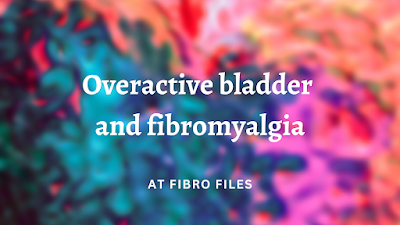Find out more about the connection between Fibromyalgia and the bladder including what is an overactive bladder, the causes and first line treatments.
What Is Overactive Bladder?
Overactive bladder (OAB) is a condition marked by sudden, frequent urges to urinate—often with or without leakage. It may also be referred to as sensory bladder, urgency, irritable bladder, or neurogenic bladder. These terms describe conditions involving increased urinary urgency and frequency due to abnormal bladder sensation or control.
Understanding the Link Between Fibromyalgia and Overactive Bladder
Many people with fibromyalgia report bladder-related symptoms, including increased urgency and frequency. In fibromyalgia, the need to urinate may not originate from typical bladder filling signals. Instead, disrupted nerve signaling may prevent the brain from correctly interpreting or responding to these sensations.
Survey Insights and Clinical Research
In a 2023 poll conducted in our Fibromyalgia support group, 33 participants reported symptoms of increased urinary urgency or frequency (irritable bladder), while only 3 said they did not experience these issues.
A 2012 study involving 920 participants found that fibromyalgia (FMS) is significantly associated with overactive bladder. The severity of FMS was found to correlate with OAB intensity.
A 2021 systematic case-controlled study confirmed a strong association, reporting that 93% of fibromyalgia patients experienced OAB symptoms. This high prevalence highlights the importance of assessing bladder symptoms in fibromyalgia patients.
How Fibromyalgia Affects Bladder Function
Normal bladder function requires coordination between muscles and nerves. Nerve signals must travel effectively between the bladder and brain to manage urination. In both OAB and fibromyalgia, this communication may be disrupted.
Shared Mechanisms Between Fibromyalgia and OAB
Central Nervous System (CNS) Sensitization
Fibromyalgia involves CNS sensitization—a heightened response to stimuli, including pain. Similarly, OAB may result from abnormal CNS signaling, leading to increased urgency and sensitivity in the bladder.Autonomic Nervous System Dysfunction (Dysautonomia)
People with fibromyalgia often exhibit dysfunction in the autonomic nervous system, which regulates bladder control. This can lead to bladder overactivity and misfiring of urgency signals.Chronic Pain Syndrome and Comorbidities
Fibromyalgia frequently coexists with IBS, chronic fatigue syndrome, and interstitial cystitis—all of which share features with OAB. This suggests a common pattern of systemic dysregulation.Neurotransmitter Imbalances
Both fibromyalgia and OAB have been linked to imbalances in serotonin, norepinephrine, and dopamine—neurochemicals involved in pain regulation and bladder control.Sleep Disturbances
Poor sleep, common in fibromyalgia, may worsen bladder symptoms. In turn, night time urination can further disrupt sleep, creating a vicious cycle.
What Causes Overactive Bladder?
There are many possible causes of OAB, and they can often overlap. These include:
Hormonal changes (e.g., menopause)
Enlarged prostate (in men)
Certain medications
Kidney problems
Herniated disc or spinal issues
Neurological conditions (e.g., multiple sclerosis)
Multiple pregnancies
Aging
Diabetes
Excess body weight
Pelvic floor dysfunction or injury
What to Do if You Have Symptoms
If you experience symptoms of OAB—frequent urination, sudden urges, or incontinence—consult your doctor. If they can’t provide adequate help, ask for a referral to a urologist.
First-Line Treatment Options for OAB
(According to The Urology Group)
Behavioral Therapy
Fluid Management: Aim for 64 oz (2 liters) of daily fluid intake.
Avoid Bladder Irritants: Limit caffeine, alcohol, spicy or acidic foods, and carbonated drinks. Quit smoking.
Weight Loss: Losing just 8% of body weight can cut incontinence episodes in half.
Bladder Retraining: Learn techniques to gradually extend the time between urination and reduce urgency.
Pelvic Floor Physical Therapy: A 4–6 week therapy program can strengthen pelvic floor muscles, often using electrical stimulation.
Resources
Urology Care Foundation
Sources
Fibro Connect Facebook Group Poll, July 2023
The Association Between Overactive Bladder and Fibromyalgia Syndrome: A Community Survey
The Coexistence of the Fibromyalgia Syndrome and the Overactive Bladder Syndrome
The Urology Group – First Line Treatments for OAB



No comments:
Post a Comment
Thanks for your input